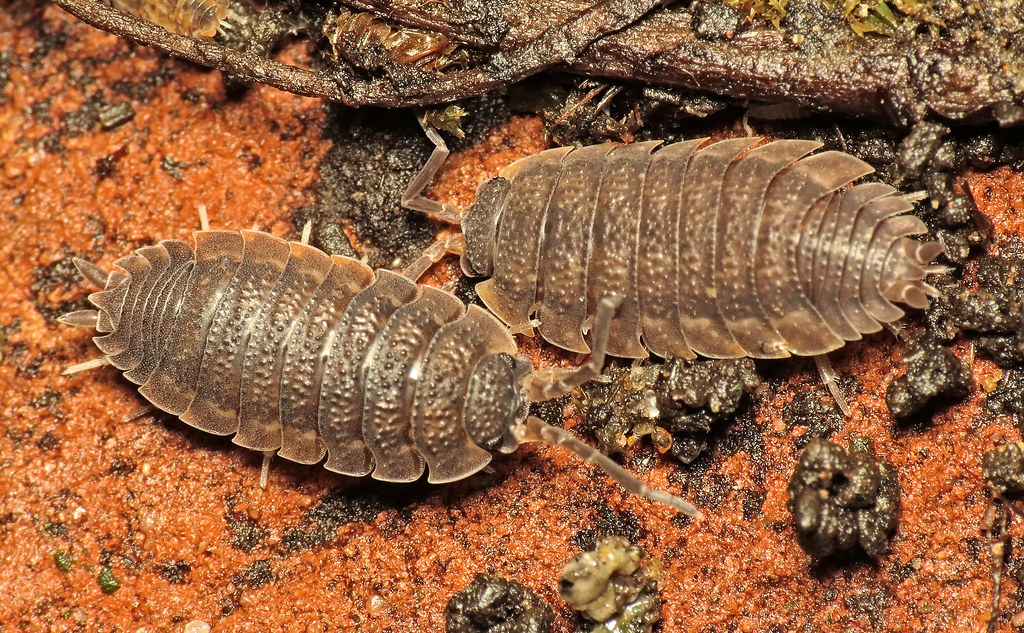
How to Get Rid of Woodlice Quickly and Easily
I. Introduction
Ever stumbled upon a tiny grey roly-poly scuttle across your bathroom floor? Those aren’t exactly welcome guests, are they? These little critters, known as woodlice (or pill bugs, sow bugs depending on where you’re from), are more common in homes than you might think.
While they might not be the most dangerous houseguests, woodlice can certainly be a nuisance. Not only are they unpleasant to encounter, but they can also cause some minor damage to your property over time. But fear not! There are ways to deal with these unwanted visitors. Keep reading to discover how to get rid of woodlice problem and reclaim your home!
II. Who are Woodlice?
Now that we’ve met our creepy crawlies, let’s know them a little deeper. Woodlice aren’t exactly fans of the limelight. In fact, you’re more likely to find them hiding out in damp, dark areas of your home – think basements, crawlspaces, behind appliances, or under leaky sinks. This preference for moisture is no coincidence. Woodlice, despite their tough exoskeleton, are susceptible to drying out. So, damp environments become their personal havens.
But wait, there’s more to these little guys than just a love for humidity. Woodlice actually play a vital role in the ecosystem. They’re decomposers, feasting on decaying leaves, organic matter, and even the occasional dead insect. In essence, they’re nature’s little cleanup crew, helping to break down organic materials and return nutrients to the soil. While their role outdoors is beneficial, their presence indoors can be less than desirable. Let’s explore why in the next section and how to get rid of woodlice.
III. Woodlice in Your House: A Sign of Trouble?
So, you’ve spotted a woodlouse in your home. While they might seem like harmless visitors, their presence could be a sign of a bigger issue.
A. Damp Detectives: Woodlice as Moisture Indicators
Remember how we mentioned in the start woodlice love damp, dark places? Well, their presence inside your house could be a red flag for moisture problems. Leaky pipes, condensation buildup, or poor ventilation can create the perfect environment for these little moisture-seekers.
B. Beyond the Nuisance Factor: Potential Property Damage
While a few woodlice probably won’t cause any major structural damage, a larger infestation can be problematic. They feed on organic matter, and unfortunately, that can include things like wallpaper paste, book bindings, and even some softer building materials like insulation. So, while they might not bite, they could leave some unwelcome marks on your belongings.
IV. How to Get Rid of Woodlice
The good news is, you don’t have to live with woodlice as unwanted roommates. Here’s where we get to the fun part: how to get rid of woodlice! But before we jump into grabbing the bug spray, let’s remember the golden rule of pest control:
A. How to Stop Woodlice at Home
Woodlice thrive in damp environments, so eliminating moisture sources is the first line of defense. Here’s how to make your home less attractive to these moisture-loving critters:
- Address Moisture Issues: Fix leaky pipes, improve ventilation in damp areas (basements, crawlspaces), and use dehumidifiers to control excess moisture.
- Seal Up Entry Points: Tiny gaps around windows, doors, and pipes can be highways for woodlice. Seal these up with caulk or sealant to keep them out.
- Declutter Damp Areas: Woodlice love to hide in clutter. Regularly clean and declutter damp areas in your home, especially basements and crawlspaces. This will remove potential hiding spots and make it harder for them to establish themselves.
By taking these preventive steps, you can significantly completed the first step of how to get rid of woodlice and prevent future infestations.
B. Natural Repellents:
After taking steps to make your home less inviting, you can consider adding another layer of defense: natural repellents to get rid of woodlice.
What smells do woodlice hate?
Believe it or not, woodlice have some pretty sensitive noses! Certain scents that might seem pleasant to us are quite repulsive to them. There are various natural options you can explore, but we’ll delve deeper into those specifics a little later.
Diatomaceous Earth (DE): A Desiccant Defense
Diatomaceous earth (DE) is a powder made from fossilized algae. It might sound fancy, but it’s a natural and relatively safe way to deter woodlice. DE works by dehydrating insects with its microscopic, sharp edges. When woodlice crawl across DE, it damages their waxy outer shell, leading to water loss and ultimately, their demise. However, it’s important to use DE with caution and follow safety instructions, as it can irritate lungs if inhaled.
By combining preventative measures with natural repellents, you can create a formidable defense against woodlice and reclaim your home!
C. Traps & Removal:
Sometimes, despite our best efforts, a woodlouse or two might sneak past our defenses. Here’s where traps and removal come in:
- DIY Woodlouse Hotels: Believe it or not, you can create your own little woodlouse motels using everyday household items. Damp newspaper or rolled-up cardboard provide a cool, damp haven that woodlice are drawn to. Simply place these traps in strategic locations and check them periodically. You can then release the captured woodlice outdoors (far from your house!) or dispose of them however you see fit.
- The Mighty Vacuum: Sometimes, the simplest solution is the best. Woodlice are slow-moving creatures, making them easy targets for your trusty vacuum cleaner. Simply suck them up and dispose of the bag outside to prevent them from finding their way back in. Remember, this method isn’t the most humane, so consider using traps if you prefer a catch-and-release approach.
Important Note: When using any removal method, be sure to empty your vacuum cleaner bag or dispose of traps outside your home to prevent the woodlice from simply re-entering.
By combining these trapping and removal techniques with preventative measures and natural repellents, you can effectively tackle a woodlouse infestation and reclaim your home from these unwelcome guests.
V. How to Get Rid of Woodlice with Chemical: A Last Resort
While we’ve explored a variety of natural and preventative methods, there are situations where a woodlouse infestation might be severe enough to warrant stronger measures. In these cases, insecticidal powders and sprays can be a last resort.
A. Chemical Solutions: Powders and Sprays
These products contain ingredients that are toxic to woodlice. Powders can be dusted in areas where woodlice are active, while sprays can be used to create a barrier or directly target the insects.
Important Considerations:
While chemical solutions can be effective, they should only be used as a last resort. Here’s why:
- Safety First: Insecticides can be harmful to humans and pets if not used properly. Always follow the label instructions carefully and take precautions like wearing gloves and a mask when applying.
- Environmental Impact: Chemical sprays can harm beneficial insects and pollute the environment. Opt for natural methods whenever possible.
B. Weighing Your Options: Safety and Effectiveness
Before resorting to chemicals, ensure you’ve exhausted all other options like fixing moisture issues, using natural repellents, and setting traps. Remember, a clean, dry environment is the best long-term solution to deter woodlice.
If you absolutely must use chemicals, prioritize safety. Choose products with lower toxicity and follow application instructions meticulously. By prioritizing these aspects, you can minimize the risks associated with chemical warfare.
VI. Will Vinegar Kill Woodlice?

The answer of the most confusion question (Will Vinegar Kill Woodlice?) is vinegar is a popular natural cleaning solution, while vinegar can irritate woodlice, it’s not the most effective way to eradicate them. Here’s why:
- Vinegar Dissipates Quickly: The acidic properties of vinegar that might deter woodlice evaporate quickly. This means the repellent effect is short-lived, and woodlice can simply return once the vinegar dries.
- Limited Contact: Creating a vinegar barrier around your entire house is impractical, and spot treatments with vinegar might not reach all the hiding places where woodlice reside.
Better Alternatives: Natural Repellents for Woodlice
While vinegar might not be the ultimate weapon, there are other natural repellents that offer a more lasting solution:
- Essential Oils: Certain essential oils, like cedarwood and clove oil, have strong scents that repel woodlice. You can use these oils in diffusers or create a spray with diluted solutions (always research safe dilution ratios for pets and children).
- Bay Leaves & Citrus Peels: The strong fragrance of bay leaves and citrus peels can deter woodlice. Scatter these around potential entry points or in areas where you’ve seen activity.
These natural repellents offer a more long-lasting and safer alternative to vinegar for keeping woodlice at bay.
VII. Conclusion: Taking Back Your Home from Woodlice
So, there you have it! Woodlice might not be the most welcome guests, but with the right approach, you can reclaim your home from these creepy crawlies. Remember, the key lies in prevention: address moisture issues, seal entry points, and keep things clean and dry.
But even with prevention, a stray woodlouse might find its way in. Thankfully, there’s a multi-pronged approach you can take:
- Natural Repellents: Utilize the power of scents with essential oils, bay leaves, or citrus peels to make your home unappealing to woodlice.
- Traps & Removal: DIY traps or your trusty vacuum can help capture and remove unwanted guests.
- Chemical Warfare (Last Resort): If the infestation is severe, consider insecticidal powders or sprays as a last resort, prioritizing safety and following instructions carefully.
By following these steps, you have the answer of your question how to get rid of woodlice?. You can effectively tackle a woodlice infestation and create a home that’s less inviting to these moisture-loving creatures. With a little effort and the right strategy, you can say goodbye to woodlice and enjoy a pest-free environment!





